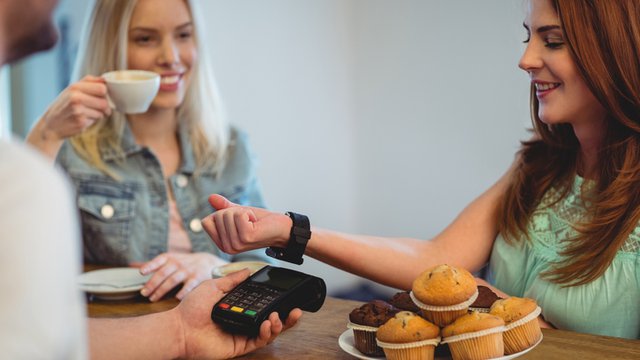When the Apple Watch first appeared, many of the reviews were less than glowing. The device was labeled confusing, and some critics thought that it would usher in an always-on world that they wanted no part of.
However, the Apple Watch outsold the iPhone in its first year after release, with some experts putting initial 12-month sales of the watch at around 12 million units. Consumers realized there was more to this device than a non-stop annoyance every time you got an email or text message.
One of the more attractive features of the Apple Watch, and indeed most smartwatches, is the ability to make contactless payments. No pulling out your wallet or swiping a card. Instead, a wave of your wrist over the payment terminal takes care of the payment.
Watches aren’t the only wearable on the market. Everything from ringsto jackets is being embedded with contactless payment technology. Current estimates put wearable payment volume at $501 billion by 2020.
Payment volume alone would be a good reason for the restaurant industry to incorporate wearable technology into their businesses. But there are more uses for these devices in the food industry than just convenience of your customers.
Payments and beyond
Certainly, payments using wearables are the first thing to consider when it comes to the restaurant industry. Give customers flexibility in payment options and you offer an attractive choice when dining, whether it’s for a nice evening out or grabbing a quick bite to eat.
Starbucks has long been a leader in innovative customer payments. From mobile apps to chip-enabled payment cards, Starbucks embraces advancements in payments, and wearables are no different. Recently, the coffee house teamed up with Japanese fashion brand, Beams, to develop a leather key fob, emblazoned with the familiar mermaid logo and embedded with the same chip as their pre-bought cards. Initially released only in Japan, the fobs sold out almost immediately.
Coffee isn’t the foodservice industry segment working to make wearable payments easy to use. McDonald’s, as part of its initiative to reinvent themselves and increase their digital presence, signed a 3-year deal with MasterCard in 2015, to roll out innovative payment operations across Africa and the Middle East. The goal is to allow customers to use a variety of payment options from mobile phones to wearables in an environment well suited to quick and easy payments.
Wearables go beyond this, helping restaurants provide outstanding customer service. Staff using wearables can be easily alerted to situations that need their attention. From managers being notified immediately of the arrival of VIP guests to servers being made aware their table just paid their bill, devices such as the Apple Watch will raise the level of service establishments can provide.
Enhanced restaurant operations
The front of the house isn’t the only place that can get a boost from staff sporting wearables. These devices can help keep management and wait staff aware of what’s going on, keeping them on top of orders, inventory and overall improve communication between the front of the house and the back.
Getting food and drinks out to customers quickly is an important component of excellent customer service. A drink that gets watered-down from sitting too long at the bar or a lukewarm steak can ruin a meal. Already in use at Who in Paris, wait staff wearing smartwatches can be informed when drinks are ready at the bar, or food is done in the kitchen. The watches allow the staff to have their hands free for other tasks and still know when their orders are up and ready to be served.
Wearable devices can be indispensable for management as well, letting them head off potential problems. With a smartwatch, a manager can know when they are needed at the register in a fast food restaurant, even if they are in the kitchen or office. On a Friday or Saturday night, the manager at a table service restaurant may be running back and forth between the bar, the kitchen, and the hostesses. With a smart watch, though, a manager can spend time with their guests, having a way to immediately be notified of needs throughout the restaurant and even being able to monitor inventory from anywhere in the restaurant.
Wearables are changing the payments industry and will continue to make a huge impact in the years to come. But in the food industry, it’s about more than payments. It’s about being able to increase in-house communication with the entire staff and elevate the customer service experience, giving you an edge over competitors in an aggressively competitive industry.
By Bonnie Moss

